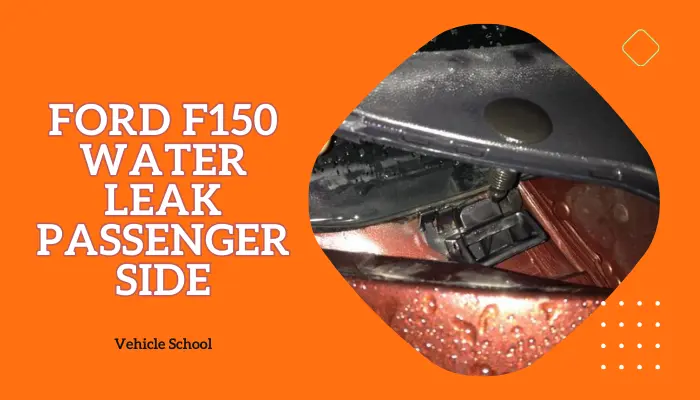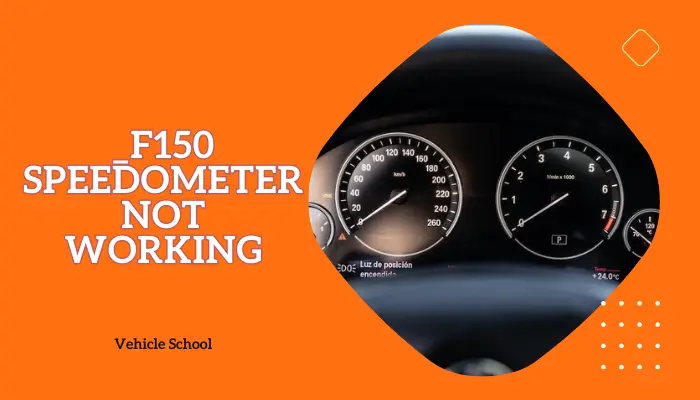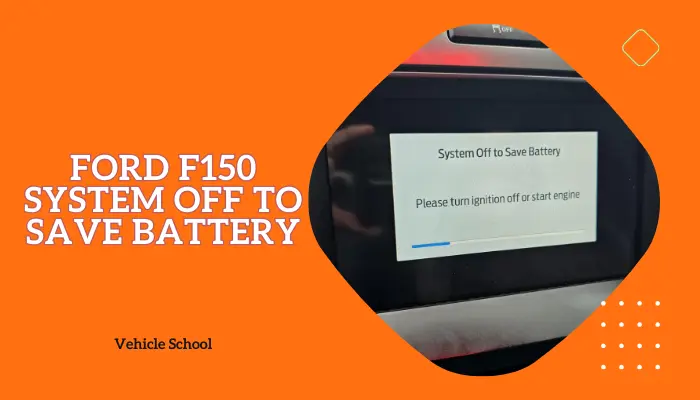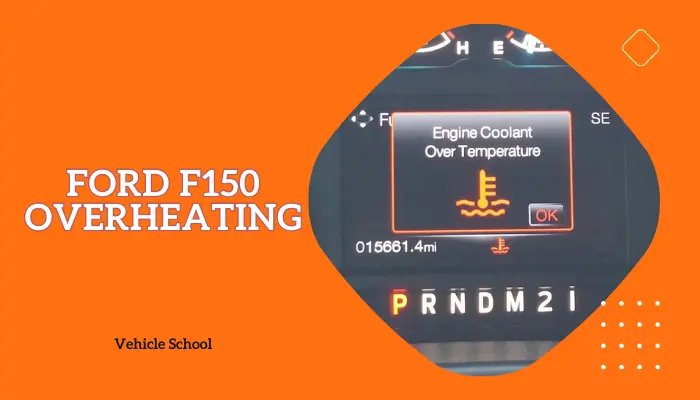Seeing the check engine light on your Dodge Ram 1500? This warning could be due to anything from a loose gas cap to a more serious issue.
You might also notice your Ram running rough or losing power. Before you worry, check out this guide. I’ll tell you how to deal with this alert. Keep reading.
What Are The Common Causes Of Ram 1500 Check Engine Light?
The RAM 1500’s check engine light often activates due to sensor issues (mainly knock or O2 sensors), ignition problems (coils, spark plugs), fuel system faults (injectors, loose gas cap), or a failing catalytic converter. ECM malfunctions and engine misfires are also common triggers. These issues cover most scenarios causing the warning light.
Let’s talk about all these reasons in more detail so you get an idea of the root of the issue.
1. Faulty Coil
The Ram 1500’s ignition coil generates the high voltage needed for the spark plugs. A faulty coil can’t produce enough spark. This causes misfires. Misfires happen when the fuel-air mixture in a cylinder doesn’t ignite.
Symptoms include rough idling and reduced engine power. The ECM detects misfires through sensors. It then triggers the check engine light.
2. Bad Injector
Fuel injectors deliver precise fuel amounts to the cylinders. If an injector clogs, it restricts fuel flow. This leads to a lean mixture, causing misfires and hesitation. A stuck-open injector floods the cylinder with fuel.
This causes a rich mixture, resulting in black smoke and poor fuel economy. The ECM uses oxygen sensors to monitor the air-fuel ratio. If it detects an imbalance, it turns on the check engine light.
3. Problematic Catalytic Converter
The catalytic converter reduces harmful emissions. It converts exhaust gases into less harmful substances. If the engine misfires, unburned fuel enters the exhaust. This can overheat the converter and cause failure.
A failing converter can’t efficiently process emissions. The ECM monitors emissions through oxygen sensors. When it detects reduced efficiency, it triggers the check engine light.
4. Loose Gas Cap
A tight gas cap is crucial for sealing the Ram 1500’s fuel system. A loose or damaged gas cap lets fuel vapors escape. This breaks the seal of the evaporative emissions control (EVAP) system.
The ECM monitors system pressure and detects leaks. When it senses a leak, it turns on the check engine light.
5. O2 Sensor Issue
Oxygen sensors measure oxygen levels in the exhaust. They help the ECM adjust the air-fuel mixture. A failing sensor sends incorrect signals, leading to improper fuel metering.
This makes the engine run too rich or lean, affecting performance and emissions. The ECM relies on accurate O2 sensor data. It will show the check engine light if a sensor malfunctions.
6. Bad Spark Plugs
Spark plugs ignite the air-fuel mixture in the engine. Over time, they can wear out or become fouled. Damaged wires also increase resistance or cause arcing. This prevents the spark from reaching the spark plugs, causing a misfire.
As in, there’s no voltage being sent from the spark plug. This leads to weak sparks or misfires. Misfires cause reduced power and increased emissions. Worn spark plugs also strain ignition coils. The ECM detects misfires and turns on the check engine light.
7. Knock Sensor Problem
The knock sensor detects engine knocking. Knocking occurs when fuel combusts too early. The sensor sends signals to the ECM to adjust ignition timing. A faulty knock sensor might miss knocking or send false signals.
This can reduce engine performance and efficiency. The ECM needs the sensor to prevent engine damage. If a sensor issue is detected, the check engine light comes on.
How To Fix Your Ram 1500 Check Engine Light Flashing Issue?
You can fix the Ram 1500 Check Engine Light issue by changing the coil pack, injector, spark plugs (or their wires), O2 sensor, catalytic converter or knock sensor. Before you get to all that, make sure it’s not just a loose cap causing the issue.
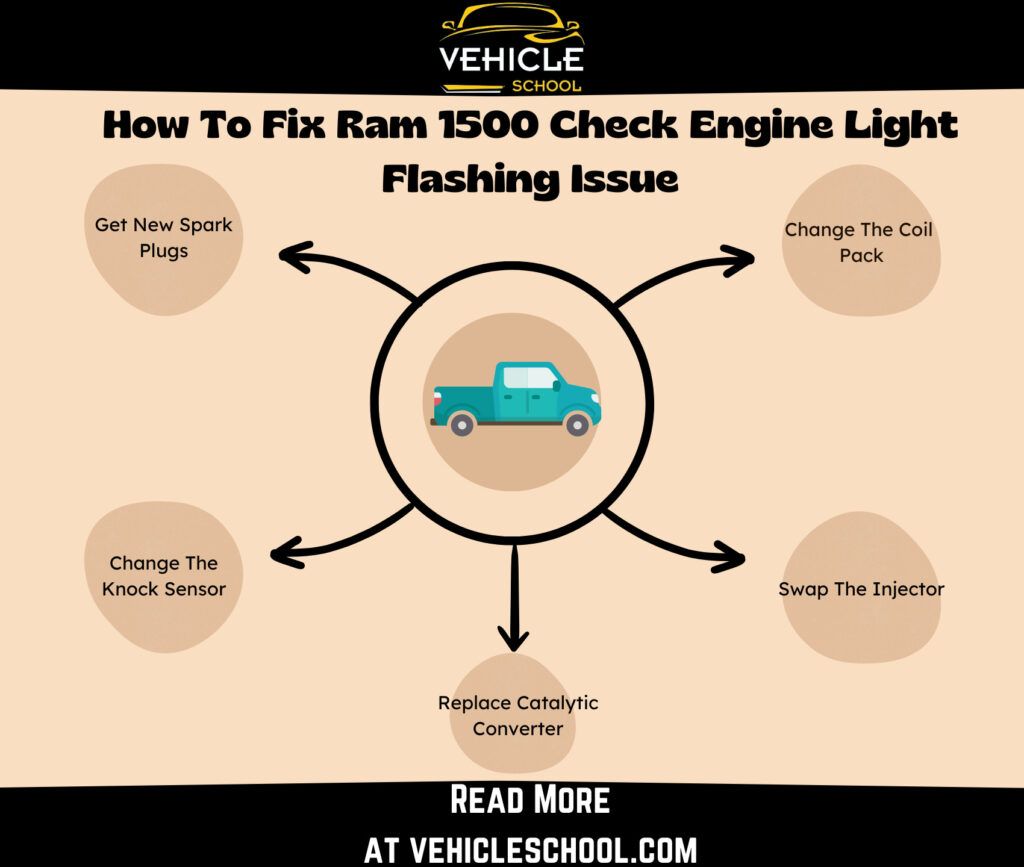
1. Change The Coil Pack
- Turn off the truck, set the brake, and pop the hood.
- Find the coils on the passenger side under the air duct.
- Loosen the clamps on the duct with a screwdriver and pull the hose off.
- Press the tab to disconnect the coil connector.
- Use a ratchet with a 10 mm socket to remove the coil bolt and take out the coil.
- Vacuum around the spark plug to clean it.
- Put in the new coil and secure it with the bolt.
- Tighten the bolt with a torque wrench.
- Reconnect the coil connector.
- Attach the duct hose and tighten the clamps.
2. Swap The Injector
- Disconnect the negative battery terminal with a 10 mm wrench.
- Loosen the intake clamps with an 8 mm socket and remove the snorkel.
- Unplug the connectors by pressing their tabs.
- Remove the intake manifold bolts and lift it off.
- Remove fuel rail bolts and lift the rail.
- Pull out old injectors and O-rings.
- Lubricate and insert new injectors.
- Reattach the fuel rail and tighten the bolts.
- Reinstall the intake manifold and tighten the bolts.
- Reconnect all connectors and hoses, then reconnect the battery.
There’s a lot more to the process—if you need a visual guide, you can check out this video:
You can use the same steps on newer Ram 1500s. Just be sure to check in with your manual in case you need adjustments.
3. Get New Spark Plugs
While you’re at it, you should check your spark plug wires. They might need replacements, too.
- Remove the air intake and filter housing.
- Cover the intake to keep debris out.
- Take off the engine cover.
- Unplug the coil connectors by pressing the tabs.
- Use a 10 mm socket to remove the coil bolts.
- Lift out the coils and set them aside.
- Blow away debris around the spark plugs.
- Remove old spark plugs with a 5/8-inch socket.
- Check the gap on new plugs, set to 0.043 inches.
- Install new plugs and tighten to 13 ft-lbs.
- Apply dielectric grease to coil boots.
- Reinstall the coils and bolt them down.
- Plug the coil connectors back in.
- Reattach the air intake and engine cover.
4. Change The Knock Sensor
This fix also usually works, you can check if it’s the right one for you by looking up your truck’s reported codes.
- Disconnect the negative battery terminal with a 10 mm wrench.
- Loosen and remove the airbox snorkel with an 8 mm socket.
- Unplug the airbox connector by pressing the tab.
- Remove the rubber coupler and any clamps around the intake.
- Use a trim tool to disconnect various connectors and retainers.
- Unbolt and lift off the intake manifold with an 8 mm socket.
- Move aside any remaining connectors and hoses.
- Remove the old knock sensors with a T40 socket.
- Install new sensors, torquing them to 16 ft-lbs, and reconnect the plugs.
- Reassemble the intake manifold, secure all bolts and reconnect the battery.
5. Replace Catalytic Converter
When swapping, you can also change out your O2 sensor if you find any codes in your truck about it or if it seems damaged.
- Jack up the truck and remove the wheel with a 22 mm socket.
- Unscrew the inner fender with an 8 mm socket and take out the shield.
- Pop off the push pins and disconnect the O2 sensor connector.
- Use a 7/8 inch O2 sensor socket to remove the upstream O2 sensor.
- Remove the catalytic converter bolts with a 10 mm socket.
- Cut off any rusted studs if needed and take out the old converter.
- Clean the mounting surface and position the new converter.
- Bolt the converter in place and tighten to 17 ft-lbs and 22 ft-lbs.
- Reinstall the O2 sensors and connectors.
- Put the inner fender and wheel back on, then torque the lug nuts to 130 ft-lbs.
- Double-check everything, and lower the truck.
These are only a few reasons for the Check Engine Light. Like with most trucks, this alert is for a whole slew of errors, both major and minor. If these don’t help, it might be time to send your truck to a proper mechanic.
How Much Will It Cost To Fix Your Ram 1500 Check Engine Light Flashing Issue?
To fix a flashing check engine light on your Ram 1500, you’ll need to pay $100 to $300 for simple fixes like a sensor or gas cap. For major issues like transmission or engine problems, costs can soar from $1,000 to $4,000 or more. If basic repairs don’t solve the issue, be ready for even higher costs and deeper diagnostics.
How To Reset Check Engine Light On Ram 1500?
To reset the check engine light on your Ram 1500 after fixing the problem, just follow these steps:
- Disconnect the negative battery cable for about 20 minutes.
- Reconnect the cable and tighten it.
- Start the engine and check if the light is off.
Alternatively, you can use an OBD-II scanner to clear the code and reset the light. Just plug in the scanner, follow the prompts to clear the codes, and turn off the engine.
FAQs
Is it safe to drive your Ram 1500 truck with a check engine light on?
Driving your Ram 1500 with the check engine light on can be risky. A flashing light could mean a serious problem like an engine misfire, which can damage the catalytic converter and lead to costly repairs. You might also experience overheating, reduced power, or even engine failure (something that could straight up lead to an accident). Even a steady light can cause poor fuel economy and more damage over time if ignored. It’s best to get it checked out quickly to avoid these issues.
Ending Remarks
Now that the light is off your to-do list, you can get back to the road without feeling like your wallet’s about to get a lot lighter.
By dealing with the check engine light promptly, you’re not only taking care of your Ram’s engine but also doing your part for the environment. A well-maintained truck is more efficient and leaves a smaller carbon footprint.

